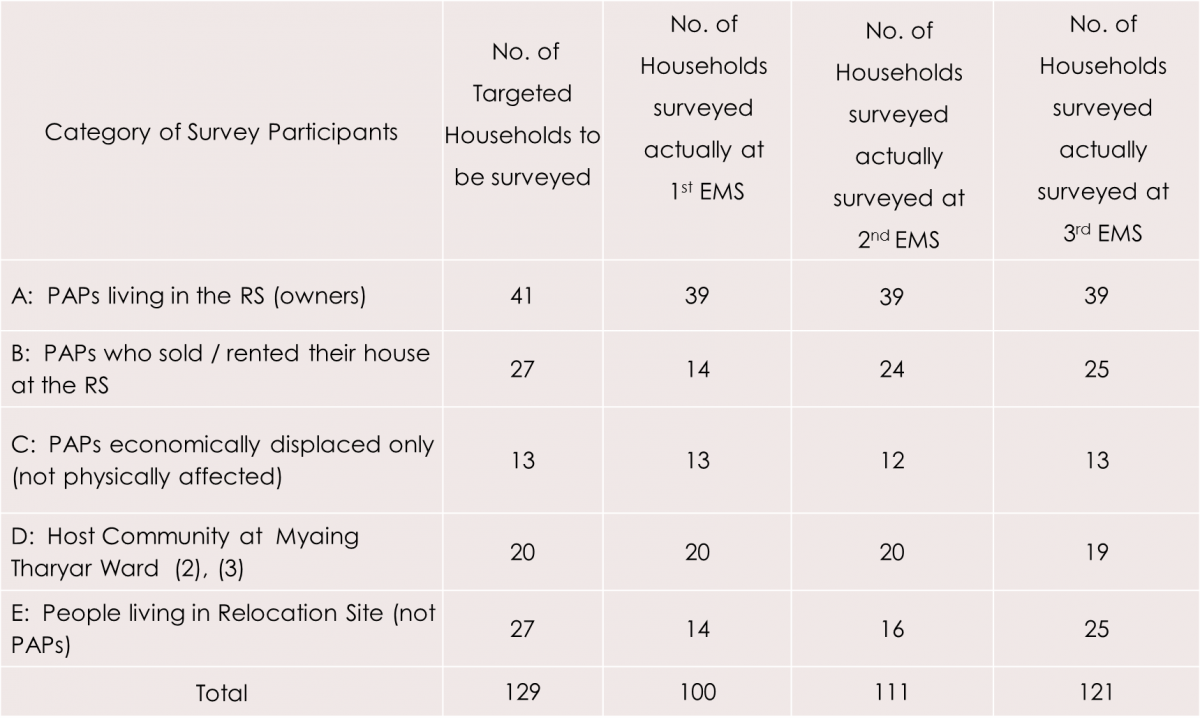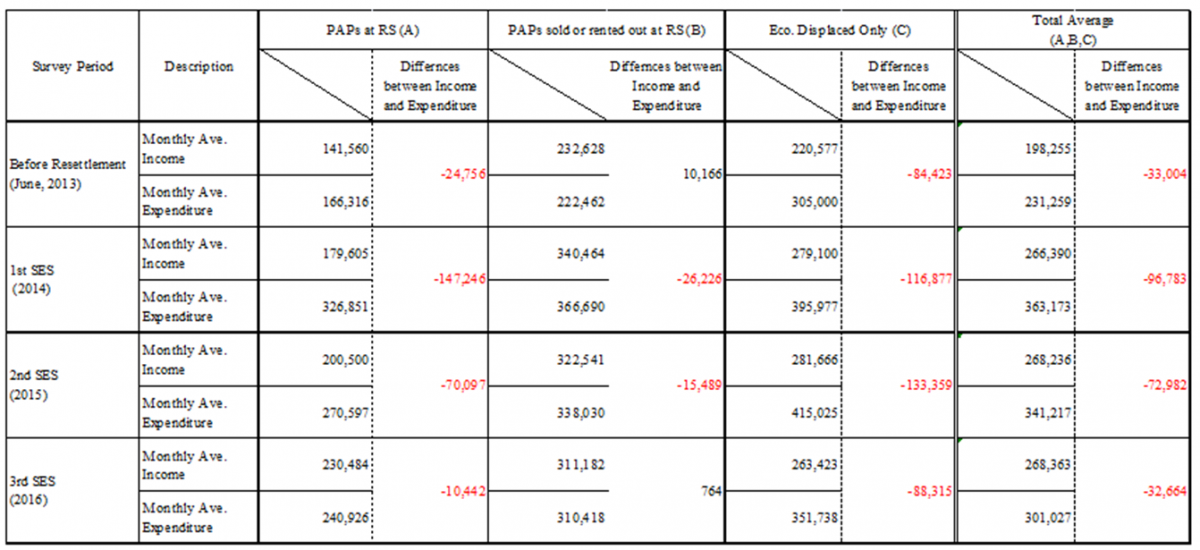Phase 1 / Zone A
The monitoring and evaluation program for the IRP has comprised both internal and external monitoring and evaluation activities.
Internal Monitoring
Internal monitoring has mainly been conducted by the Thilawa SEZ Management Committee (TSMC) to assess progress in livelihood restoration prior to and after the relocation of the PAPs.
As shown in the diagram below, internal monitoring has been undertaken at two levels: at the practical/field level by TSMC; and at the official level by the related Government of Myanmar (GoM) sub-committees.
At the practical/field level, monitoring has been undertaken on a regular basis and progress has been reported to the Income Restoration Program Implementation Sub-Committee (IRPISC). It is planned that field level internal monitoring will be handed over to the village tract administrator based near the RS (RS) to enable more direct monitoring.
In addition, living condition at RS has been conducted every one or two weeks since 2014. Please see Weekly Monitoring Report. (http://www.irpthilawa.com/weekly-report)
External Social Economic Survey (SES)
During resettlement implementation, external monitoring is often required by the resettlement work plan (RWP) and international lending agencies such as JICA, the World Bank and Asian Development Bank (ADB), in order to: (1) provide an independent periodic assessment of implementation of the RWP, (2) verify internal monitoring results, (3) analyse the social and economic outcomes for displaced persons compared to their socio-economic status prior to resettlement, and (4) suggest corrective measures for issues identified during the review.
To date, three SES reports have been prepared by external consultants. The first report was prepared by TWA, national consultant team, guided by Social Clarity, international consultant. The second and third monitoring reports have also been prepared by TWA.
A number of different categories of PAPs were targeted for the monitoring survey SES as well as members of the Host Community at Myaing Tharyar (2) & (3) for a comparison with the resettled/displaced population. It was also important to obtain data from new residents at the RS, including those who have rented or purchased houses from PAPs. The following lists the different categories of people targeted for the survey, the number of households targeted in each group and the number actually surveyed.
Table Target Groups for SES

The first SES was undertaken in October 2014. This was a socio-economic survey that considered the following parameters after resettlement: demography; livelihoods, income and expenditure; food security; housing and infrastructure; perception of living conditions and infrastructure at the relocation site; ownership of moveable assets; education for children; health care; environmental conditions; participation in the Income Restoration Program (IRP); and communication, social networks and cohesion.
Key observations/outcomes from the first survey included:
- More than two-thirds of PAPs reported an increase in their expenditure since relocation/displacement and many have less income than expenditure.
- In accordance with drastic social change from a rural atmosphere to semi-urban lifestyle, particularly for the PAPs at the RS, household expenditures have increased (e.g., most food consumption, clothes have to be bought more frequently than before and accommodation to be good enough for safety and security).
- 96% of children above 5 years old are attending school which is higher rate than pre-resettlement level.
- Overall PAPs at the RS have a mostly positive perception of their living conditions and infrastructure compared to before the resettlement. Most are closer to their children’s school than before, have better road conditions, better toilet facilities and significantly better house conditions.
- However, all groups ( Group A to E)surveyed reported some issues with standing water around their houses and yards
- Other issues that said by PAPs at the RS included noise problems and bad smells; which are reportedly due to overflow of the latrines (pits).
The second SES was conducted in October 2015. This considered the same factors as the initial survey.
Key observations/outcomes from the second survey included:
- Odd jobs, wage workers and home businesses were common livelihoods, with only a few PAPs still doing rice farming and cash crops. At the time of the survey, more PAPs were raising livestock compared with before resettlement.
- Amongst PAPs, in general, income had slightly increased at the time of the second survey. In particular, those that were wage workers and managing home-based businesses increased their income, while those that were undertaking odd jobs slightly decreased their income.
- Although PAPs’ expenditure still outweighed their income, provision of home account training to PAPs at the RS had contributed to bringing their expenditure into closer alignment with their income.
- 100% of children above 5 years old surveyed are attending school.
- A variety of vocational training had been provided to PAPs based on needs analysis consultation with them, however many livelihood activities required capital investment and also marketing skills. Further investment and training was needed.
- PAPs at the RS had a high dependency rate because of having larger families but less employment.
- A modified grievance mechanism had been developed which had improved PAPs’ ability to raise concerns and have these resolved.
- Internal monitoring was being systematically undertaken with the support of the IRP team. In particular, the conditions of wells, drainage, roads, garbage pit, toilets, electricity provision, living status of PAPs (house ownership and current usage) and other issues such as drainage conditions in compounds, plantations, livestock raising and other observations were monitored through weekly field visits.
The third SES was undertaken in July 2016. This reviewed the same aspects as the initial survey undertaken in December 2014.
Key observations from the third survey included:
- The stability of household head jobs had increased significantly since the second monitoring survey, and the nature of many peoples’ employment had changed.
- Average income had increased amongst all PAPs except some of those that sold or rented houses at the RS and those that were economically displaced (rather than physically displaced).
- Average expenditure decreased amongst most groups although, for some, it still exceeded their average monthly income. In particular, the deficit for PAPs living at the RS had decreased since the second monitoring survey. The Social Welfare Support Program (SWSP) was seen as having been beneficial in this regard.
- The following table shows all categories of PAPs (A-C) have a difference in income and expenditure at the third EMS that is very similar to their pre-resettlement conditions; indicating that their livelihood situation is generally stabilized.

- Savings amongst resettled peoples (Group A) had increased, in particular in response to microfinance initiatives introduced through the IRP.
- 96% of children above 5 years old surveyed are attending school.
- Standing water at houses in the RS had been significantly decreased due to soil compaction activities undertaken by the IRP.
- Odour at the RS due to poor waste management had decreased due to a TSMC initiative to regularly collect waste at the site.
- Further vocational training had been undertaken to support PAPs. Amongst other benefits, this had resulted in some PAPs securing employment at the SEZ. Also, some PAPs had developed home-based businesses that produce and sell mushrooms grown at the RS.
- In addition, there had been improvements regarding awareness of job vacancies at the SEZ, through notices being published at the RS.
The IRP has an ongoing focus on supporting stable employment for PAPs, including through a focus on job matching.
To date, around 23 PAPs have secured employment at the SEZ including eight who have commenced work on an organic farming project. PAPs are employed at the SEZ in roles including organic farming, electrical maintenance, cleaning, security and tailoring. Four factories currently employ workers. Others are employed with MJTD and the JICA Expert Team. In addition, another 14 people have previously been employed through the SEZ.
For further information on SES, see more ............
